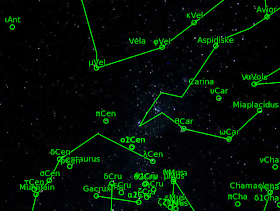The Loss of the Night app came about because of my research into the citizen science data from the GLOBE at Night project. The first GLOBE at Night data came in on March 22, 2006, so a few hours from now GLOBE at Night is going to turn 8 years old! Congratulations to Connie Walker, and everyone else on the GLOBE at Night team at NOAO!
The third GLOBE at Night campaign of 2014 begins tonight, and even if you prefer to use the Loss of the Night app or the Dark Sky Meter app, I hope that you will take a moment to take part in GLOBE at Night this month. The reason is that the time series for GLOBE at Night stretches back further, and observations taken using the same method are much easier to compare to each other. Since the original GLOBE at Night campaign began in March, additional observations from March each year are more important than those in any other month.
So if it's clear where you live, please take a few minutes to go outside and look up at the stars in the next ten days!
Friday, March 21, 2014
Wednesday, March 5, 2014
Skyglow over South Africa
Markus Pössel from the German Haus der Astronomie recently returned from South Africa, and realized that some of the photos he took nicely demonstrate the effect of skyglow. What's really great about the photos is that they not only have the same camera settings, he also set up the shot to be of the same part of the sky. He gave me permission to re-post the photos from his SciLogs post here.
He took three photos and overlaid them one above the other. The top photo shows the sky over Grahamstown (population 70,000). The middle photo has the same settings as the top, but was shot in Sutherland, near the South African Astronomical Observatory. The bottom photo is the same location as the middle photo, but with an exposure time twice as long to reveal more details.
You can get the full resolution version of the images at Markus's SciLogs post.
If you have a good image about skyglow or lighting, please send it to me, and I'll share it on the blog! You can see the entire light pollution photo series by clicking on the "view from your app" label below.
He took three photos and overlaid them one above the other. The top photo shows the sky over Grahamstown (population 70,000). The middle photo has the same settings as the top, but was shot in Sutherland, near the South African Astronomical Observatory. The bottom photo is the same location as the middle photo, but with an exposure time twice as long to reveal more details.
 |
 An example of light pollution by Markus Pössel is licensed under a Creative Commons Attribution-ShareAlike 4.0 International License. The top two photos have identical camera settings, the bottom photo had an exposure time that was twice as long. |
 |
| The area of the sky that was photographed. The Southern Cross is at the bottom. Constellation overlay via astronomy.net |
You can get the full resolution version of the images at Markus's SciLogs post.
If you have a good image about skyglow or lighting, please send it to me, and I'll share it on the blog! You can see the entire light pollution photo series by clicking on the "view from your app" label below.
Monday, March 3, 2014
Multiple observations at the same location
I recently got a question via twitter:
The answer is that multiple observations are extremely valuable to us, especially at this early stage. There are several reasons for this:
So please feel free to make observations as often as you like and observe as many stars as you like (going past 7 stars is helpful). But most of all, please plan to come back to the same location in the future and see if the sky has changed!
@skyglowberlin Just wondering, would multiple measurements on different days on the LON app from the same location help or harm project?
— Aashay (@Crowning_Gory) March 2, 2014
Thanks for the question Aashay! The answer is that multiple observations are extremely valuable to us, especially at this early stage. There are several reasons for this:
- Observations from multiple people at the exact same time are very useful, because it helps us understand how different people perceive the night sky and how they interact with the app.
- Observations from the same person at different times on a single night help us understand curfew effects (the sky over most cities gets darker as the night goes on).
- Observations from the same person on different days at about the same time within the same month help us understand how consistent the app's results are with changing atmospheric conditions and clarity, as well as with the changing stars that it asks you for (there is some randomness built in).
- Observations from the same person several months apart are helpful for us because the stars change with the seasons. We are also trying to understand which stars are easier to decide upon and which are problematic, so the more stars you observe the better.
So please feel free to make observations as often as you like and observe as many stars as you like (going past 7 stars is helpful). But most of all, please plan to come back to the same location in the future and see if the sky has changed!
